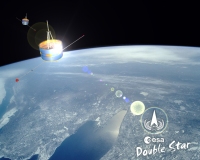Double Star mission extension approved by ESA
12 May 2005
On 10 May 2005, the ESA Science Programme Committee (SPC) approved the extension of the Double Star mission for a period of 17 months, pushing back the end date from July 2005 to December 2006.
 |
|
Artistic view of the TC-1 and TC-2 satellites of the Double star mission. |
The Double Star Programme (DSP) was first proposed by China in March 1997. It is the first project of international collaboration between China and ESA.
Under the present collaboration agreement, ESA committed itself to contribute to the construction/refurbishment and pre-integration of eight European instruments, acquisition of data for 4 hours per day and coordination of scientific operations for the European instruments. China's contribution includes the two spacecraft buses, eight scientific experiments, launch and spacecraft operations.
The orbits have been designed to complement the Cluster mission by maximizing the time when both Cluster and Double Star are in the same scientifically interesting regions. The two missions allow simultaneous observations of the Earth's magnetosphere from six points in space. To facilitate the comparison of data, half of the Double Star payload (with the exception of the NUADU instrument) is made up of spares or duplicates of Cluster experiments; the other half consists of new Chinese instruments.
The first year of DSP operations, in combination with Cluster, has brought many new results concerning the boundaries of the magnetosphere. We can see for the first time, the evolution of structures and physical processes at small scales, within the Cluster tetrahedron, and then at large scales with Cluster and Double Star.
Scientific Highlights of the nominal mission
Three scientific highlights obtained during the nominal phase of the mission will now be briefly underlined.
Magnetic reconnection found preferably around the subsolar point
- Simultaneous Double Star and Cluster observations of plasma jets at the subsolar point and near the cusp, suggest that reconnection is initiated near the subsolar point and then propagates to the cusp
- Observations of electromagnetic waves with a power 10 times higher at the subsolar magnetopause than near the cusp, which could explain why reconnection takes place preferably at the subsolar point
Observational first on ring current imaging
- First energetic neutral atom images of the full ring current simultaneously from both south and north poles (TC-2 and the NASA IMAGE spacecraft). These data are used to better understand the overall morphology of the ring current and its behaviour during geomagnetic storms
Species-dependent deceleration at the Earth's bow shock revealed
- First prolonged observations of the Earth's bow shock acquired, as the Double Star orbit skimmed the bow shock, showing the shock structure in unprecedented detail. Analysis of such observations by TC-1 showed that the deceleration of H+ ions is half that of the deceleration of He++ ions. These observations will help to model shocks, not only in front of the Earth's magnetosphere, but also in front of other planets and astronomical objects
Why an extension?
Due to orbit mechanics and the fact that some processes (like geomagnetic storms) occur only very rarely and at varying locations, during the first year only a few good conjunctions with Cluster could be exploited. More observations of these key magnetospheric processes (reconnection for example) are essential to fully understand them. The approved extension of 1.5 years will allow the number of conjunctions to be doubled on the dayside of the magnetosphere and to be tripled in the magnetotail.
The other scientific arguments to extend the Double Star mission are:
- To perform the first simultaneous measurements at small, medium and large scales in the magnetotail (respectively at 1000, 10 000 and 60 000 km) by Double Star and Cluster, which will facilitate the study of substorm processes and the determination of the location of substorm break-ups
- To detect bursty bulk flows (BBF; see also "Spatial scale of high-speed flows in the magnetotail") propagating Earthward (by Cluster), investigate their causal and temporal relation to the current disruption (by TC-1 and TC-2) and, in 2006 (orbit drift), to observe the extent of BBF and current disruptions in azimuth (by Cluster and TC-1)
- To acquire sequences of "stereo" ring current ENA images by TC-2 and IMAGE, together with in-situ radiation belts measurements by TC-1 and Cluster allowing cross-calibration with the imagers
- To measure the size of large-scale structures at the magnetopause/cusp.
CAS (Chinese Academy of Science) and CASC (China Aerospace Corporation) have made a joint proposal to CNSA (China National Space Administration) on the extension of TC-1 and TC-2. The proposal is under evaluation by CNSA and the Chinese scientists are optimistic to get this extension also approved on their side very soon.
Web story author
Arnaud Masson, SCI-SH division, RSSD, ESA, The Netherlands.
Tel: +31-71-565-5634
Web story editor
Philippe Escoubet, SCI-SH division RSSD, ESA, The Netherlands.
Tel: +31-71-565-4564

